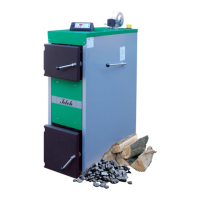NOTE: It is prohibited to kindle the boiler with flammable liquids, such as
gasoline, kerosene, solvents, etc.
12. REFUELING THE BOILER
NOTE: Fuel humidity should not exceed 25% (recommended humidity is about 20%).
Before you start refueling the boiler switch off the fan, open the by-pass device
and after a few seconds open the fuel loading door. Do these operations slowly. This will
allow for gently burning of gases collected in the fuel loading chamber. This will also prevent
“explosions” of gas. The flue gas coming out of the boiler during this operation indicates a
defective chimney, dirty boiler or a blocked burner.
Fuel should be refilled periodically by filling up the whole fuel loading chamber. The
fuel stock in the fuel loading chamber suffices for 4,5 to 10,5 hours depending on the fuel
used and boiler operating power. Before you add a fresh portion of fuel, remove ash and
cinder, if any from the boiler grate and burner. While cleaning, “we put the rake into the gap
between the furnace door and grate”. Due to that we can avoid of falling out from the boiler
bigger parts of burning medium.
Note: If after cleaning the grate you find out that the burner is partly or totally uncovered, it is
recommended that you proceed following the kindling procedure, i.e. load the chamber to
about ½ (if you use only wood fuel, you can load the fuel chamber full) with fuel (preferably
with dry wood) and leave the bottom door (about 1cm) and the by-pass device ajar for a few
or a dozen or so minutes until the entire burner is cover by glowing embers. If different fuel is
used instead of wood (or it has not been loaded full previously), e.g. coal, load the fuel
loading chamber full. Then close the door, the by-pass device and switch the temperature
control on. If you fail to do this, and there is little glowing embers, achieving the required
boiler operating temperature will take longer or the boiler can even go out.
Burning intensity (boiler output) is controlled by increasing or reducing the fan power
(see the control operation manual). Boiler water temperature decrease can indicate that the
boiler requires cleaning or improper fuel is used. Please remember that the burning time
depends on the weight of fuel loaded and not on its volume.
It is recommended that you refuel the boiler before the previously loaded fuel goes out
completely, so that the glowing ambers cover the entire burner (up to the burner top
edge), since then the fuel loaded gasification is significantly improved. During the periods of
low hot water consumption, adjust the blowing time and frequency so as to prevent boiler
going out completely by itself. Boiler water temperature (not to be confused with system
water temperature) should range between 65 and 95°C (± 10°C in relation to the set boiler
operating temperature of 80°C). For this purpose th e temoregulatory valve with 61°C on
return, specified in Point 7, is required.
13. BOILER CLEANING
In order to ensure fuel economy make sure the combustion chamber and convection
ducts are kept clean. The boiler cleaning frequency depends mainly on burning intensity, fuel
quality (its humidity) and chimney condition.
The combustion chamber should be cleaned through the bottom door, while the
convection chamber through the cleanout from the rear side of the boiler, after removing its
covers. Soot and ash from the breeching is removed after opening the cleanout on the
breeching. The best method for removing dirt from convection ducts is to pull it down from
each shelf, starting through the cleanout and starting from the top. The dirt will fall down into
the after-burning chamber and can be removed through the burner with a special scraper into
the fuel loading chamber and from here down into the ashpit. Tar produced as a result of the
burning process is deposited on the fuel loading chamber side walls. This is typical for
bottom burning boilers.

